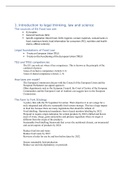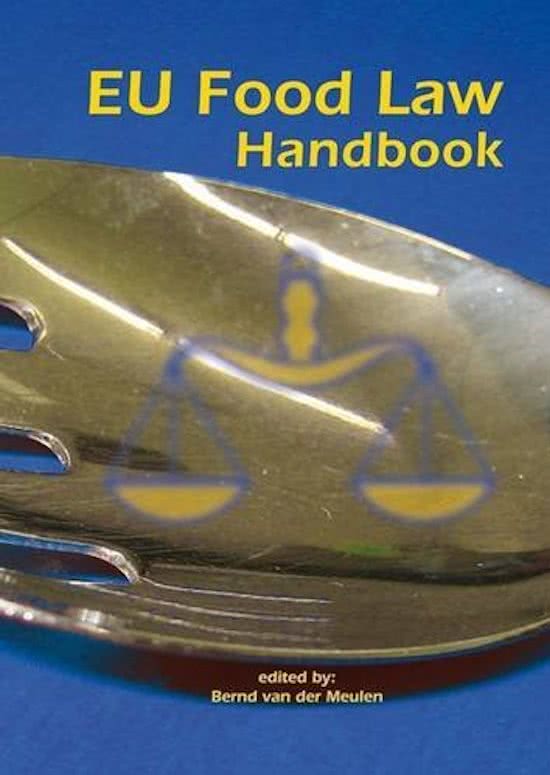1. Introduction to legal thinking, law and science
The sources of EU Food law are:
EU treaties
General Food Law (GFL)
Specific Legislation (Novel food, GMO, hygiene, contact materials, contaminants in
food, maximum levels, food information for consumers (FIC), nutrition and health
claims, official controls).
Legal foundations of Food Law
Treaty on European Union (TEU)
Treaty on the Functioning of the European Union (TFEU)
TEU and TFEU competencies
The EU can only act where it has competence. This is known as the principle of the
conferral of power:
Areas of exclusive competence (Article 2-3)
Areas of shared competence (Article 2, 4)
How laws are made?
The European Commission discuss with the Council of the European Union and the
European Parliament can appeal against it.
Other departments such as the European Council, the Court of Justice of the European
Communities and the European Court of Auditors can suggest laws to the European
Commission.
The Farm to Fork Strategy
A policy that calls the EU legislator for action. Their objective it to set a stage for a
truly integrated and effective sustainable food system strategy. This has a huge impact
in food law because there are many legislations that should be rethink of:
Food labelling: Harmonized mandatory front of pack nutrition labelling by 2022.
Proposal to require origin indication for certain products by 2022 (chilled and frozen
meat of swine, sheep, goats and poultry and primary ingredient where its origin is
different from the origin of the product).
Sustainable food labelling framework that covers the nutritional climate, environmental
and social aspects of products by 2024.
Reduce food lost and waste
Reduce food waste by 2023
Revision of rules for use by and best before dates by 2022.
Ensure sustainable food production
Reduce use and risk dependency on pesticide.
, Etc.
Stimulate sustainable food processing, wholesale, retail, hospitality and food services
practices.
Reading
Consolidated Version of the Treaty of the EU
Four main principles of the EU: free movement of people, goods, services, and..?
Open of the internal market
Exceptions such as national protected stuff should be valued?
What else?
Consolidated version of the treaty of the functioning of the EU
It talks about how the EU works.
Shared and unshared powers between MS and the EU.
Definitions for regulation, directive, decision, recommendations and opinions.
What else?
182/2011: Rules and general principles concerning mechanisms for control
by MS of the commissions exercise of implementing powers.
Common market, single market and internal market
2. Introduction to EU substantive law
The four freedoms of the EU are:
Free movement of labour
Free movement of capital
Free movement of services
Free movement of goods
Free trade between members: Article 30 TFEU
Common external tariffs: Article 31 TFEU
Factor mobility across borders: Article 34-35 TFEU
This treaties helped to change the perceptions of the benefits of harmonization
Dassonville: Measures of equivalent effect to quantitative restrictions
Cassis de Dijon: Principle of mutual recognition
Limitation for this freedom: Article 36 TFEU
Other justifications:
Effectiveness of fiscal supervision
Protection of public health
Fairness of commercial transactions
Defence of the consumer
,Four phases of food law
1. Product standards: Cassis de Dijon
2. Horizontal approaches: 1169/2011 (labelling), 1999/2/EC (ionizing radiation),
89/108/EEC (Quick frozen foodstuffs)
3. Food Safety Law: White paper on food safety risk assessment, risk management, risk
communication
4. Farm to fork strategy: Food sustainability
Reading
European Commission White Paper on Food Safety
The white paper was a new vision for the future shape of EU food law. Before the BSE crisis,
EU food safety law was subordinated to the development of the internal market. After the crisis,
it was clear the need to restore and maintain consumer confidence to restore their trustworthiness
of the institutions concerned. To achieve this, the Commission proposed an ambitious legislative
programme: 84 legislation and policy initiatives were schedule for the near future. Also the
Commission backed the establishment of a new European Food safety authority (EFSA), to serve
as the scientific point of reference for the whole Union, and thereby contribute to a high level of
consumer health protection.
In the White Paper national authorities are held responsible to establish control systems and carry
out programs of audits and inspections to evaluate the performance of national authorities against
their ability to deliver and operate effective control system supported by acceptable standards.
Core elements of the framework:
1. Operational criteria set up at Union level
2. The development of Union control guidelines
3. The enhancement of administrative cooperation in the development and operation of
control systems
The first step in the realization of the reform of food law was planned in the White Paper on
Food Safety was the passage of regulation No 178/2002 of the European Parliament and of the
Council, laying down the general principles and requirements of food law. The popular name of
this regulation is the General Food law (GFL)
From mutual recognition to mutual scientific opinion? Constitutional
framework for risk analysis in EU food safety law
Without discussing here the myriad of political aspects of its practical application to EU multi-level food safety
governance, this legal structure built upon the principle of risk analysis adds a new dimension to the development
of the internal market. Because the judicial review of scientific evidence is limited to formal require- ments, the
close cooperation and integration of scientific expertise within the Community have a theoretical potential to
develop a common scientific position on food safety issues and thus to con- tribute to eliminating barriers to intra-
Community trade. While mutual recognition is the EU answer to obstacles to the free move- ment of goods created
by different national technical and quality standards, the approximation of scientific risk assessments offers a
solution to different understandings of food safety.
, Case 120/78 Cassis de Dijon
A German chain of supermarkets sought to import Cassis de Dijon, a fruit liqueur, from France.
The German authorities refused to authorize the import because the alcohol content was 20%
which is lower than 25% that is the least alcohol content allowed by German national product
standards.
The German authorities argued that such low percentage could induce people to develop
tolerances for alcohol more quickly and that consumers trusting the law might feel cheated.
Finally, they submitted that in the absence of such a law beverages with low alcohol content
would benefit from an unfair competitive advantage because taxes on alcohol are high, and
beverages with lower alcoholic content have lower prices.
The Court held that type of argument as relevant since they met an urgent need supported by the
rule of reason.
However, the Court found that Germany’s public health argument did not meet this standard
considering the availability of a wide range of alcoholic beverages on the German market with
low alcohol content of less that 25%. Thus, the court suggested that the risk could be eliminated
with a label displaying the alcohol content.
Cassis de Dijon has become a symbol for the principle of mutual recognition that establish that
what is good enough for consumers in one MS is good enough for consumers across the Union.
But concerns about the product standards raised. The limitations of the principle of mutual
recognition highlighted the need for further harmonization of product requirements at the
European level. Emphasis shifted from product specific, vertical legislation, to horizontal
legislation, meaning general rules addressing common aspects for all foodstuffs, or at least for as
many foodstuffs as possible.
3. The General Food Law
General objectives: protection of human life, consumers interest and free movement of food
(article 5 GFL). Public authorities, national authorities, consumers, FBO.
The risk analysis principle: Food law shall be based on risk analysis (article 6 GFL).
Precautionary principle: reasonable grounds for concern and information and data are not
sufficiently complete (article 7). Preventive measures shall be proportionate, no more restrictive
trade than is required, reviewed within a reasonable period of time.
General Food safety pillars
Article 2 and 3 are dedicated to legal definition.
Before GFL there was no definition to food.
Food and feed safety
General principles
a) General objectives: article 5 protection in high level of human life and health and free
movement of food.
b) Risk analysis principle: article 6 ensure food safety






